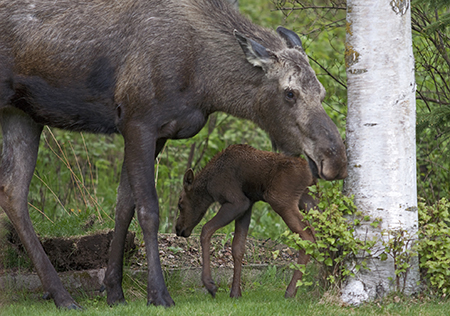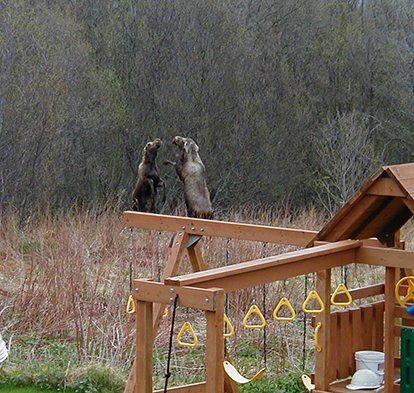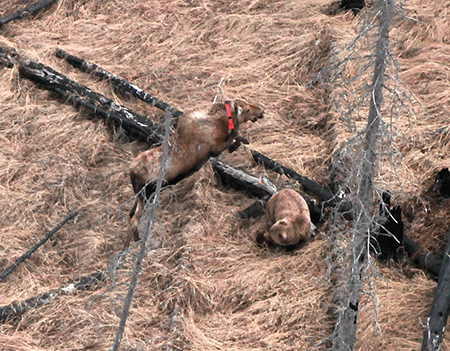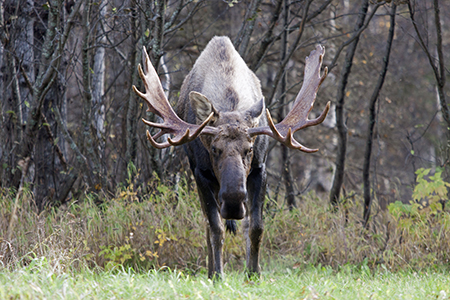Which Animals Kick With Their Back Legs
Alaska Fish & Wildlife News
Jan 2020
Boot and Stomping
Moose Hooves are a Formidable Defense
By Riley Woodford

Moose calves are targets for predators similar wolves and bears, and mother moose are famously defensive of their vulnerable young. Photo by Ken Marsh.
Moose are not usually aggressive just they can be dangerous under certain circumstances. More than people are injured in Alaska past moose than by bears.
Unlike bears, moose don't bite. They kicking. In a moose's earth, where bears and wolves want to eat you lot and are particularly eager to eat your babies, kick and stomping can be a formidable defence force. Sometimes people wind up on the wrong stop of those hooves, usually belonging to a defensive mother moose.
In belatedly May of 2019, a man walking his canis familiaris in an Hawkeye River neighborhood was attacked when he inadvertently got betwixt a cow moose and her calf. A few weeks later, a man in Colorado suffered a like fate in a like situation.
In winter, moose tin be ambitious when harassed past people, dogs and traffic, and are more likely to exist hungry, tired and frustrated with deep snow. In January of 1995 a 71-year-onetime man was killed on the University of Alaska Anchorage campus by an ambitious moose.
Predators are injured and killed past moose, and biologists offered a wait into the ability of the moose's all-time defense.
The 360 kick and moose battle
Wildlife biologist John Crouse is a moose researcher and serves as director of the Kenai Moose Research Center. He's worked with captive and relatively tame moose, and wild moose, for decades and seen a wide variety of moose behavior, including their interactions with each other and with people. He said moose are agile and can kicking in all directions.
"They more often than not kick with their front end legs," he said. "That's nigh common, simply it depends. Sometimes they get annoyed and they'll kicking back. If they feel threatened, they tin can kill you with a hind leg kick."
When a moose delivers a hard, fast boot with its hind leg, Crouse said you tin can hear the tendons and ligaments pop and snap when the hoof comes back at the stop of the kick. They can kicking straight ahead and volition also rear up and stomp.
"The front leg will come straight upward with that hoof, they'll also come up frontward and kick out at the side, and they tin can come up down as well, on to the tiptop of your head or shoulder," he said. "From what I've observed they can pretty much kick 360 degrees around them."
It'southward common for moose to boot each other. There is a bureaucracy in a group, and that club might be stable for a catamenia, only Crouse said it's dynamic. Information technology changes with the flavour, their mood, and whether a cow has a calf. Outside the breeding period conflicts are mostly associated with nutrient, he said.
"They're browsing and 1 moose wants a particular shrub. Often, they accept it sorted out, you'll run into their ears lowered and other forms of communication, but if they don't have it worked out, they'll be kicking, or standing upward on their hind legs and battle each other. They'll do that occasionally to usa, rear upward on their hind legs. Instead of being six or seven feet alpine at the shoulders, they're nine anxiety in the air, and their legs are above your shoulder. Their head is well above yous; and the hooves are to a higher place your head."
He said bull moose spar with their antlers when they take them, but when they've dropped their antlers they'll rear upwardly and box like the cows.

A pair of Homer-area moose "boxing" - rearing upwards and kicking at each other with their front legs. Note the ears are lowered and laid dorsum. Photo ADF&G.
Moose become frustrated and Crouse described what he called moose tantrums.
"They'll get so upset about something sometimes they have to accident off that free energy," he said. "They'll run around in circles, their pilus is all erected and up straight; they will run with their legs jerking out and kicking sideways."
Wildlife biologist Layne Adams noted that moose are good at kick on the run. "Elk will do that too, it'southward astonishing how they can lash out with a hoof while running at a pretty good clip," he said.
Moose and predators
Layne Adams worked with moose and wolves in Denali, and spent decades studying caribou. He's with the USGS in Anchorage at the Alaska Scientific discipline Eye. He said biologists who work with wolves ofttimes see healed injuries of 1 kind or some other, particularly to wolves living in areas where they chase moose rather than caribou or deer.
"Nosotros picked upwardly animals over the years that had cleaved legs, and I doubtable some or virtually of those came from altercations with moose," he said. "I wouldn't say they're common, merely information technology'south not surprising to see them. Wolves are tough animals, they deal with a lot of corruption and are able to get those healed up and keep to alive."
He cleaned wolf skulls over the years, boiling, scraping and picking out all the meat. One skull displayed evidence of a remarkable healed injury.
"When I was done you could meet that nigh one-quarter to one-tertiary of the brain case was pushed in, and it pretty much followed the shape of the side of the hoof of a moose," he said. "It was pretty easy to flick that wolf had been kicked in the caput, and it had healed."
He picked upwards a expressionless wolf in Denali that was almost certainly moose killed, he said. "The ribs were kicked in, smashed in, and from where information technology was lying it didn't expect similar information technology had fallen off a cliff or annihilation like that."
He added that John Blake at UAF performed a necropsy and determined it died from edgeless strength trauma to one side of its ribcage.
Ane incident stood out. He and a colleague were in a helicopter tracking a collared female wolf. As the pilot brought them in, they saw the female person and her mate standing beside a river. They darted the male and equally they were putting on a radio collar, they saw a moose continuing off in the bushes and realized what was happening.
"They had bloodied him upwards pretty skillful," he said. "The wolf had been limping and had blood on his fur. Nosotros put it together - he and his mate were in the procedure of trying to impale this moose. The wolf'southward hind leg was cleaved."
They collared the injured wolf and left and checked back the next day.
"They were eating that moose," he said. "I suspect the mate was instrumental in bringing down that moose.
That male person was killed a few months later by another wolf, or wolves, and since he was collared, they were able to locate and retrieved him. When Adams examined that cleaved leg, he said information technology was healed.
"It was like it was splinted with ossification," he said. "Bony material that forms in and amongst the muscle tissue around the suspension, layers of it. We've defenseless other wolves that had broken legs healed like that."

Biologists tracking this radio-collared moose from the air witnessed information technology rearing upwards to stomp a predatory conduct. Photo past Gerald Lee.
Retired Fish and Game biologist Rod Boertje saw similar injuries in his long career in Interior Alaska working with moose, wolves and bears. In the grade of a project where radio-collared wolves were tracked to evaluate the cause of death he said a couple were killed by moose.
He wrote: "Broken and healed ribs and fractured and healed skulls were non uncommon among wolf carcasses I examined from the Fortymile country, where moose are a predominant prey. Pretty uncommon for wolves to die from a moose kicking but I do call up 2 of 23 translocated wolves (Fortymile wolf translocation project) that died in the start year after translocation were killed by moose."
Patrick Endres related a outset-hand account of a battle betwixt a moose and a grouping of wolves. Endres is a Fairbanks-based professional wild fauna lensman and writer. In June of 2010 he was working in Denali National Park and photographed a heated fight between a female parent cow moose and members of the Grant Creek wolf pack who were trying to grab her young calf.
The battle occurred in a modest, shallow pond, surrounded by a willow thicket. Endres said the cow and calf moved out of the willows to the pond right before the wolves showed up.
"I think she sensed the wolves appearing," he said. "They didn't come at one time as a large pack, and somewhen at that place was a total of five. The pond was the merely area free of obstructions, and I doubtable she went there for visibility and mobility."
The cow charged and kicked at the wolves, mostly using her front end feet, merely as well with her back legs. The wolves were never really later on her, they wanted the calf, he said. The calf stayed close, frequently taking protection under the cow herself, and he thinks she might've stepped on the dogie at some point, just it was difficult to tell every bit there was so much motion and action.
At that place was a tremendous corporeality of water flying, he said. "She was stomping a lot, non really rearing upwards like a horse, but stomping with her front anxiety. She was really ferocious; information technology would've been fatal if she'd connected."
He said he did not run across her connect with a solid kick, and he didn't see any wolves limping or acting similar they'd been kicked or stepped on. There was some contact, but nothing serious.
"They are extremely cunning, those wolves," he said. "To encounter their agility and the strategic fashion they moved in and out. Ane would motion in and get her attention, then the others would come up in from the back or the sides. Information technology was amazingly orchestrated."
Subsequently about 10 minutes both the cow and the calf became visibly weakened and drawn, and he said eventually a couple of wolves grabbed it. "The cow was wearied, and in that location seemed to be a sense of resignation that she lost, merely information technology's hard to know what an animal is thinking."
Endres is likely correct, as in that location is a pragmatic biological element to the moo-cow's resignation. Biologist Rod Boertje too saw predators take moose calves from defensive female parent moose.

A bull moose in oestrus in Kincaid Park. Photo by Ken Marsh.
"At that place were a couple instances where the cow defended as well long and ended up in the burial pile along with twin calves," he wrote in an email. "Must be hard for development to fine tune how aggressive to be when defending offspring."
He described an incident from the mid-1980s that stood out, where a cow lived to fight another day. He was tracking a radio-collared grizzly comport from a small-scale airplane and defenseless up to a male comport (a boar) that was on a scent. He wrote:
"A boar I was radiotracking was on a gallop with its nose to the ground, blood-hound way. Up alee near a 1/2 mile I could see a cow and calf (maybe 2 weeks former) moving away through the scattered bandbox at a relatively slow footstep. The cow turned and faced the bear with the dogie backside the cow a few yards. The boar didn't hesitate to come right at the cow. On his first approach, the cow boxed and sent the boar in a somersault backwards. The boar didn't seem too fazed and hardly hesitated to arroyo once again caput on with a similar response. On the third approach the boar reached around the cow'south head and scraped out a noticeable corporeality of hair from the cow's left shoulder and she immediately retreated to her correct. The boar was on the calf immediately thereafter.
That boar was at least 300 pounds maybe 350, not huge but larger than the sows I had collared. The amount of balance and agility it must take for a roughly ane,000-pound cow to exercise that to a running 300+ pound plus grizzly is almost unimaginable."
It is besides incredibly effective. If a moose can arrive to two years of age, mortality from predation by bears and wolves is quite low. Boertje and his colleagues Graham Frye and Don Young studied moose mortality in the Cardinal Tanana Flats surface area of Interior Alaska and published the results in the January 2020 effect of the Journal of Wildlife Management. Wolves kill a significant number of moose calves, and are increasingly able to kill moose equally they grow beyond about eight years one-time, but an developed moose in its prime is a formidable adversary for a predator.
Riley Woodford is the editor of Alaska Fish and Wildlife News and produces the Sounds Wild! radio programme.
Lifetime Sex-Specific Moose Mortality During an Intentional Population Reduction: Journal of Wildlife Management January 2020
Living with urban moose
Condom around aggressive moose
Patrick Endres photography
The Grant Creek wolf/mother moose encounter
Video – Staying safe around moose: A 12-infinitesimal video on prophylactic effectually urban moose, produced past ADF&G and middle schoolhouse students at Mirror Lake School. Target audition is third-fifth graders.
Receive a monthly observe about new problems and articles.
Source: https://www.adfg.alaska.gov/index.cfm?adfg=wildlifenews.view_article&articles_id=939
Posted by: levittaphism.blogspot.com

0 Response to "Which Animals Kick With Their Back Legs"
Post a Comment